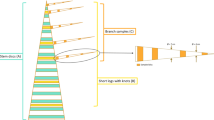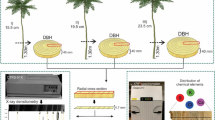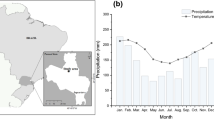Abstract
Eucalyptus plantations have been considered for bioenergy production and hence their biological characteristics that make them amenable to intensive short-rotation forestry. Wood density is an important parameter that directly affects fuel production. This study focuses on the early assessment of density features for 19 Eucalyptus species using X-ray microdensitometry in a perspective of potential biomass production. Average ring density, earlywood density, latewood density, latewood percentage and the heterogeneity index were studied. E. polyanthemos registered the highest mean wood density value (0.84 g cm−3), and E. viminalis showed the lowest value (0.53 g cm−3). An indicator for the potential wood biomass (PWB) was calculated, with E. maculata displaying the highest biomass production index (13.4 kg). Comparison of radial growth of these species showed appreciable differences. The PWB indicator points to the prospective good aptitude for short-rotation cycle for biomass production of E. maculata, E. botryoides, E. globulus, E. nitens and E. sideroxylon.







Similar content being viewed by others
References
Börjesson PII (1996) Energy analysis of biomass production and transportation. Biomass Bioenerg 11(4):305–318
Cancela-Calviño M, Bará-Rubido M, Effen E (2012) Do Eucalypt plantations provide habitat for native forest biodiversity? For Ecol Manag 270:153–162. doi:10.1016/j.foreco.2012.01.019
Ceulemans R, McDonald J, Pereira J (1996) A comparison among eucalypt, poplar and willow characteristics with particular reference to a coppice, growth-modeling approach. Biomass Bioenerg 11(2–3):215–231. doi:10.1016/0961-9534(96)00035-9
Cruzado C, Merine A, Soalheiro R (2011) A management tool for estimating bioenergy production and carbon sequestration in Eucalyptus globulus and Eucalyptus nitens grown as short rotation woody corps in north-west Spain. Biomass Bioenerg 35:2839–2851. doi:10.1016/j.biombioe.2011.03.020
Forrest M, Moore T (2008) Eucalyptus gunnii: a possible source of bioenergy? Biomass Bioenerg 32(10):978–980. doi:10.1016/j.biombioe.2008.01.010
Forrester D, Medhurst J, Wood M, Beadle Ch, Valencia J (2010) Growth and physiological response to silviculture for producing solid-wood products form Eucalyptus plantations: an Australian perspective. For Ecol Manag 259(9):1819–1835. doi:10.1016/j.foreco.2009.08.029
Gominho J, Lourenço A, Miranda I, Pereira H (2012) Chemical and fuel properties of stumps biomass from Eucalyptus globulus plantations. Ind Crop Prod 39:12–16
Gonzalez R, Treasure T, Wright J, Saloni D, Phillips R, Abt R, Jameel H (2011) Exploring the potential of Eucalyptus for energy production in the Southern United States: financial analysis of delivered biomass. Part I. Biomass Bioenerg 35(2):755–766. doi:10.1016/j.biombioe.2010.10.011
Guo L, Sims R, Horne D (2002) Biomass production and nutrient cycling in Eucalyptus short rotation energy forests in New Zeland. I: biomass and nutrient accumulation. Bioresour Technol 85(3):273–283. doi:10.1016/S0960-8524(02)00118-9
Inagaki T, Schwanninger M, Kato R, Kurata Y, Thanapasse W, Puthson P, Tsuchinkawa S (2012) Eucalyptus camaldulensis density and fiber length estimated by near-infrared spectroscopy. Wood Sci Technol 46(1–3):143–155. doi:10.1007/s00226-010-0379-6
Johansson T, Karačić A (2011) Increment and biomass in hybrid poplar and some practical implications. Biomass Bioenerg 35(5):1925–1934. doi:10.1016/j.biombioe.2011.01.040
Kim NT, Matsumura J, Oda K, Cuong NV (2009) Possibility of improvement in fundamental properties of wood of acacia hybrids by artificial hybridization. J Wood Sci 55(1):8–12. doi:10.1007/s10086-008-0993-1
Knapic S, Louzada J, Leal S, Pereira H (2008) Within-tree and between-tree variation of wood density components in cork oak trees in two sites in Portugal. Forestry 81(4):465–473. doi:10.1093/forestry/cpn012
Koubaa A, Zhang SYT, Makni S (2002) Defining the transition from earlywood to latewood in black spruce based on intra-ring wood density profiles from X-ray densitometry. Ann For Sci 59:511–518. doi:10.1051/forest:2002035
Kumar A, Luma RK, Parveen, Kumar V (2010) Variability in growth characteristics for different genotypes of Eucalyptus tereticornis (SM.). J For Res Jpn 21(4):487–491. doi:10.1007/s11676-010-0103-2
Kumar R, Pandey K, Chandrashekar N, Mohan S (2011) Study of age and height wise variability on calorific value and other fuel properties of Eucalyptus hybrid, Acacia auriculaeformis and Casuarina equisetifolia. Biomass Bioenerg 35(3):1339–1344. doi:10.1016/j.biombioe.2010.12.031
Labrecque M, Ion Teodorescu T, Daigle S (1997) Biomass productivity and wood energy of Salix species after 2 years growth in SRIC fertilized with wastewater sludge. Biomass Bioenerg 12(6):409–417
Liberloo M, Calfapietra C, Lukac M, Godbold D, Zhi-bin L, Polle A, Hoosbeek MR, Kull O, Marek M, Raines C, Rubino M, Taylor G, Scarascia-Mugnozza G, Ceulemans R (2006) Woody biomass production during the second rotation of a bio-energy Populus plantation increases in a future high CO2 world. Glob Change Biol 12(6):1094–1106
Louzada JL, Fonseca F (2002) The heritability of wood density components in Pinus pinaster Ait. and the implications for tree breeding. Ann For Sci 59(8):867–873. doi:10.1051/forest:2002085
Mackensen J, Bauhus J (2003) Density loss and respiration in coarse woody debris of Pinus radiata, Eucalyptus regnans and Eucalyptus maculata. Soil Biol Biochem 35(1):177–186. doi:10.1016/S0038-0717(02)00255-9
Mannes D, Lehmann E, Cherubini P, Niemz P (2007) Neutron imaging versus standard X-ray densitometry as method to measure tree-ring wood density. Trees Struct Funct 21(6):605–612
Mckendry P (2002) Energy production form biomass (part 1): overview of biomass. Bioresour Technol 83(1):37–46. doi:10.1016/S0960-8524(01)00118-3
Mmolotsi R, Teklehaimanot Z (2006) The effect of initial tree-planting density on timber and wood-fuel properties of red alder and sycamore. Can J For Res 36(6):1475–1483. doi:10.1139/x06-029
Mothe F, Sciama D, Leban M, Nepveu G (1998) Localisation de la transition bois initial-bois final dans un cerne de chêne par analyse microdensitométrique. Ann For Sci 55(4):437–449. doi:10.1051/forest:19980404
Oliveira JTS, Hellmeister JC, Tomazello Filho M (2005) Variation of moisture content and basic density in the wood of seven species of. Árvore 29:115–127 (In Portuguese)
Oliveira BRU, Latorraca JVF, Tomazello Filho M, Palermo GPM, Nascimento AM e Pastro MS (2012) X-ray microdensitometry applied to determination of wood density variation of Eucalyptus grandis W. Hill trees. Sci For 40(93):13–22. ISSN: 1413-9324
Pereira H, Miranda I, Tavares F, Quilhó T, Graça J, Rodrigues J, Shatalov A, Knapic S (2011) Quality and technological use of eucalyptus (Eucalyptus globulus). Centro de Estudos Florestais, Lisbon. ISBN: 978-972-97874-3-0 (In Portuguese)
Pérez S, Renedo CJ, Ortiz A, Mañana M, Delgado F, Tejedor C (2011) Energetic density of different forest species of energy crops in Cantabria (Spain). Biomass Bioenerg 35(11):4657–4664. doi:10.1016/j.biombioe.2011.09.008
Polge H (1978) Fifteen years of wood radiation densitometry. Wood Sci Technol 12:187–196
Raymond CA, Muneri A (2001) Nondestructive sampling of Eucalyptus globulus and E. nitens for wood properties.I. Basic density. Wood Sci Technol 35:27–39
Razakamanarivo RH, Razakavololona A, Razakafindrakoto MA, Vieilledent G, Albrecht A (2012) Below-ground biomass production and allometric relationships of Eucalyptus coppice plantation in the central highlands of Madagascar. Biomass Bioenerg 45:1–10. doi:10.1016/j.biombioe.2011.01.020
Rockwood DL, Carter DR, Langholtz MH, Stricker JA (2006) Eucalyptus and Populus short rotation woody crops for phosphate mined lands in Florida USA. Biomass Bioenerg 30:728–734
Rozenberg Ph, Franc A, Cahalan C (2001) Incorporating wood density in breeding programs for softwoods in Europe: a strategy and associated methods. Silvae Genet 50(1):1–7
Senelwa KS, Sims REH (1999) Fuel characteristics of short rotation forest biomass. Biomass Bioenerg 17(2):127–140. doi:10.1016/S0961-9534(99)00035-5
Sharma SK, Rao RV, Shukla SR, Kumar P, Sudheendra R, Sujatha M, Dubey YM (2005) Wood quality of coppiced Eucalyptus tereticornis for value addition. IAWA J 26(1):137–147
Silva MLFM (1998) Quality study (anatomical, chemical and papermaking) of eucalypt wood production (E. globulus and E. camaldulensis) in intensive systems of very short duration. Dissertation, Technical University of Lisbon (In Portuguese)
Turnbull JW (1999) Eucalypt plantations. New For 17:37–52. ISSN: 0169-4286
Walker NC (1988) Calculation of wood density variation from x-ray densitometer data. Wood Fiber Sci 20(1):35–43
Acknowledgments
This study was funded by project EucPlus—New processes and uses for eucalypt woods (PTDC/AGR-CFL/119752/2010) by FCT (Fundação para a Ciência e Tecnologia, Portugal). The Centro de Estudos Florestais is a research unit funded by FCT within the POCTI-FEDER programme. The first author acknowledges funding from FCT as a postdoctoral researcher. We thank warmly Dr. Paula Soares for providing the samples and the information about the trial. The trial was sponsored by CELPA—Associação da Indústria Papeleira (Portuguese Pulp and Paper Industry Association).
Author information
Authors and Affiliations
Corresponding author
Rights and permissions
About this article
Cite this article
Knapic, S., Pirralho, M., Louzada, J.L. et al. Early assessment of density features for 19 Eucalyptus species using X-ray microdensitometry in a perspective of potential biomass production. Wood Sci Technol 48, 37–49 (2014). https://doi.org/10.1007/s00226-013-0579-y
Received:
Published:
Issue Date:
DOI: https://doi.org/10.1007/s00226-013-0579-y




